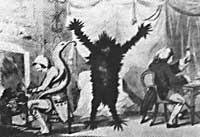The bite, a feeling that we still do not know what is
1989/04/01 Agirre, Jabier - Medikua eta OEEko kidea Iturria: Elhuyar aldizkaria
What impression does the noise of the nails on the slate produce? Quiet. Don't go and continue reading. With just thinking, chills occur to anyone. Do we know why? Science has a lot to say, but it has not yet solved the problem.
A survey conducted with the aim of analyzing the event we know as the “hens back” has given us a curious list of things that make us create the bite. First, the nails and the slate appeared. And then, the most unpleasant thing would be the noise the dentist makes. Other reasons that appear in the list are the noise made by a balloon when walking, the foam of polystyrene, the annoying noise of some markers, the noise of brake intrigue, the background noise of a car alarm or the narrowing of the spears.

The symptoms are chills, irritations, or irritations that accelerate the heart beat, or this annoying toothache. But the reasons are very particular for different people. Some feel chills when they have talc powders between their fingers or when they touch some ceramic object. However, for others, this annoying feeling should be seen by removing the balls from a jumper, watching the ice break, or making dips to the nails. It is not a phobia or a special hobby, it is not just fear. What happens is that the simple watching or listening bothers us.
There are many words that we describe this feeling: disgust, bitterness, self-consciousness... The anthropologist Alan Dundes of the University of California considers that all are inappropriate terms. I do not think there are precise words to define the phenomenon of the nail against the slate. The best is the expression “oilo-ipurdi”. The term chills is related to illness and fear of fear.
But whatever its name, this phenomenon of "dwarf chickens" seems universal. It is a fact that has been able to collect in all places and cultures. Although it is not yet very clear, something seems to have happened in human evolution. Such a universal response would have some value at a given time for survival. For most neurologists, bite would be no more than a reflection of the primitive struggle or response of escape. An adrenaline discharge from Bapate responds to the autonomous nervous system: blood vessels are contracted and the hair is cleared.
When closing the capillaries, the blood is separated from the skin, the face peels, the body shakes. The muscles contract and it seems that all our hair is bigger and more dangerous. William McClure, director of the University of California's Neurology and Behavior program, says a totally irrational response. It is a set of emotions with more than 50,000 years of history, fighting with the increasingly sophisticated society of our day, a memory of the oldest parts of our brain.
When these structures are activated, we immediately alert ourselves, although we do not know why. Perhaps, and this is nothing more than an assumption, because the sounds that annoy us so much are similar to those that would produce the sharp clutches of a leopard against a rock. The message was clear to our ancestors: leave us and don't look back.
Some consider that the answer is purely biological because of the way the inner ear and part of the brain, called 44 areas, process sound. These annoying sounds would indicate that the spectrum of the ear is saturated. This explanation does not clarify, however, the opposition of people to talc powders or jumper balls.
Psychoacoustics aims to explain the problem by another way. Science that studies the forms of human response to sounds. When recording and analyzing the noise produced when a slate is released, the representative wave is very complex. In specialized laboratories, certain recording frequencies are eliminated to see the response of different people to those reduced or filtered versions. Initially, it was thought that the high frequencies were responsible for this aversion. But after eliminating these frequencies, people continued to respond in the same way.
Therefore, psychologist Randolph Blake and his colleagues think that it is not an acquired or learned aversion, but a characteristic of our biology. Is there in nature a sound similar to that produced by the nails against the slate? The waves of different noises or noises were analyzed, and the most similar were the alarm cries of chimpanzees. Along this path, Blake suggests performing an experiment to analyze the response of the sound of nails on the slate to chimpanzees.
There are other points still unsolved. At what age do they begin to feel discontent through those sounds? Are older people more sensitive than young people? Do both sexes react the same?
Blake has heard his recordings hundreds of times and has always felt chills. Although, as he himself says, these chills are not always unpleasant.
In a study conducted in 1980 by the pharmacological Avram Goldstein, almost half of his 249 patients were put on the chicken's ass and a knot in the throat when listening to music, watching film or going to the theater, before a spectacular landscape or listening to a heroic scene taken from a book. The chills always began in the neck to spread to the face and hair. Then they opened to the shoulders and arms to descend through the column. According to Goldstein, this path is limited by a part of the brain related to the emotions and functioning of the autonomous nervous system.
To see if these sensations depended on the regulation of endorphins, Goldstein asked them to listen to a musical piece. Then he gave them naloxone (drug that blocks the action of endorphins) and repeated the experience. Three patients no longer felt chills. Goldstein believes that with high doses the restlessness of all patients could end and disappear.
As we have seen, science can clarify how it happens, but not why it happens. It is curious that at this moment when our emotions are so superficial, let us maintain that capacity or capacity to feel chills throughout evolution. However, most of the initial questions remain there: Why do they vibrate and those sensations? Are they just a trace of the fears and threats our ancestors have suffered? Or is there still any other element that science has not clarified? The future will give us light; from the past we only receive silence.

Gai honi buruzko eduki gehiago
Elhuyarrek garatutako teknologia





